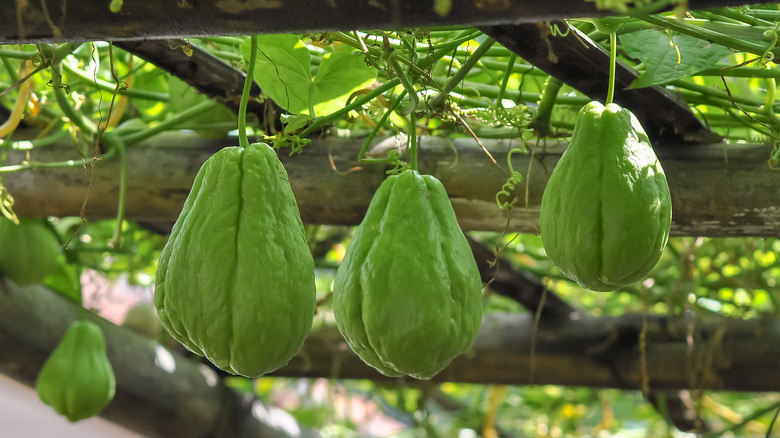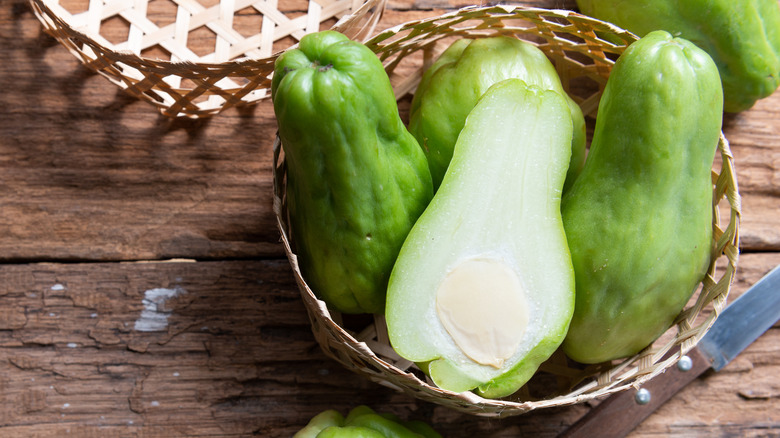Here's Why You Should Start Eating Chayote
Chayote is a plant native to Mexico and Latin America that has become grown worldwide. It's a member of the squash family and, like a tomato, is technically a fruit, per Shape. This plant has many names, including choko (or chocho), mirliton squash, vegetable pear, and mango squash, and it is a beloved ingredient in its native countries. Now, like so many other foods, its popularity is increasing and it's becoming a healthy food that is more accessible than it had been previously.
Chayote has a history of being good for the body. Historically, its leaves have been used to make a tea said to dissolve kidney stones (via Gourmet Sleuth). Eating it for its benefits today then should come as no surprise with such an astounding history. Eating it can be fun, too, as it's incredibly versatile. It can be used raw in salads, sautéed, stir-fried, and stuffed, among other preparations (via Yummly).
What makes this versatile food so good for you, though? Continue reading for our guide on the power of chayote squash.
The many positive qualities of chayote
Chayote has numerous positive qualities that make it a squash you're going to want to keep your eyes on. It's very nutrient dense, meaning you're gaining a lot of nutrients in a small amount of squash. Healthline reports that it's packed with manganese, zinc, copper, potassium, and magnesium, along with vitamins C, B6, B9, and K. Moreover, because it's full of folate, it "promotes proper cell division" in the body, per Healthline.
What's more, chayote is low in carbs, fat, and calories, but it packs a punch with antioxidants. Healthline reports that chayote is known to have the antioxidants quercetin, myricetin, morin, and kaempferol in it. It is also full of fiber, which helps one's digestive system. All of these positive attributes together mean that when you eat chayote, you're giving your body a lot of what it needs to run properly without bogging it down with carbs and fat, of which chayote doesn't have much.
Continue reading to see what chayote can do for your body.
What chayote's benefits mean for the body
Because chayote is full of vitamins, minerals, and antioxidants that are good for the body (and barely any carbs or fat), eating chayote on a recurring basis can lead to several potential health benefits.
Healthline reports that eating chayote may lower one's blood sugar, support one's digestive health, promote a healthy weight, support liver function, slow visible signs of aging, and many other benefits. This may seem like a miracle, but it's simply because of its percentage of nutrients. For example, Healthline reports that one serving of chayote offers 26% of one's recommended daily intake of Vitamin C. It also offers 19% of one's recommended daily intake of manganese. It's not just that this squash has all of nutrients in it — it's the high concentration of them.
As with any food, though, you want to eat it as part of a balanced diet, and you can't expect to get everything you need from it. But what it does offer is a perfect ingredient to incorporate into your diet to make sure you're getting enough nutrients.
Continue reading to see where you can buy chayote.
Here's how you can find chayote
Chayote is available in some grocery stores' produce departments, but if you cannot find it there, Shape notes that you may be able to find it at specialty grocers such as Whole Foods. They furthermore explain that chayote is more likely to be readily accessible year round in places with warmer climates due to it being a summer fruit that grows in heat. Still, it's worth looking for, and you may even be able to find it online.
Gourmet Sleuth adds that in the U.S. chayote are being farmed in three states: Louisiana, California, and Florida. When buying chayote, you should purchase it when it's smooth — you want to avoid chayote that have wrinkled in the store. Moreover, you want to use it when it's fresh. They note that it can be stored in the refrigerator for a few days but it's best eaten as soon as you can after buying it.
Eating it when freshest means you are getting the most amount of nutrients as well!



